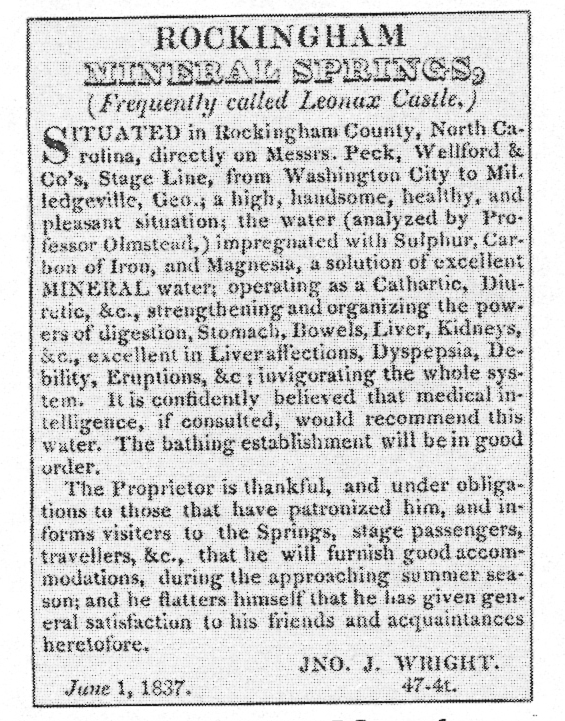 |
||||
|
|
||||
 Soon after the American Revolution, but more frequently towards the end of the eighteenth century and the beginning of the nineteenth century, natural springs became one of the many new "fads" and quickly became fashionable all across the country. This was also true in North Carolina, and even Rockingham County, which boasted a well-known resort at Rockingham Springs in the 1780s (perhaps earlier). By the late 1790s, Mr. John Lenox had acquired Rockingham Springs and renamed it to Lenox Castle. Residents of neighboring Moravian communities, such as Salem in nearby Stokes County (at the time - now Forsyth), recorded their visits to the springs, and in 1790, Alexander Martin, then governor of North Carolina, convened a meeting of the Council of State here. John Lenox equipped his resort with a patented shower and soon began advertising it as "The Castle of Thundertontrenck." At nearby High Rock, gentlemen could engage in horse racing, cockfighting, and playing cards. This was truly the place for high-rollers. Archibald D. Murphey, a noted Hillsborough attorney, visited the resort due to poor health, and he ultimately purchased it from Lenox in 1807. Thomas Ruffin, later Chief Justice of the State Supreme Court and a relative of Murphey by marriage, also owned the resort for a time. Situated in the southeast portion of Rockingham County, Lenox Castle was roughly 12-15 miles southeast of Wentworth, the County Seat, and only a couple of miles east of the Caswell County line. Interestingly, most of the maps produced in the early 1800s clearly show the town, but it is referred to as Rockingham Springs. In 1839, it shows up as Lenox Castle - long after John Lenox had sold the place. On June 20, 1799, Lenox Castle was granted a US Post Office, and its first Postmaster was (surprise) Mr. John Lenox. This PO remained in operation until May 2, 1837. The second incarnation of Lenox Castle (at the same location) was when it received its second US Post Office on January 5, 1846, and its new Postmaster was Mr. Henry Brannock. This PO remained in operation until January 31, 1905, when it was closed permanently. There are no records to indicate what transpired for nine years between 1837 and 1846, and it is currently unknown as to why the town "dried up" in the early twentieth century. |
 |
 |
© 2007 - J.D. Lewis - PO Box 1188 - Little River, SC 29566 - All Rights Reserved